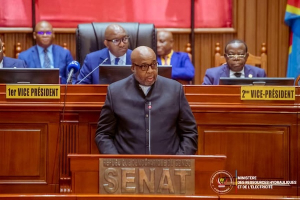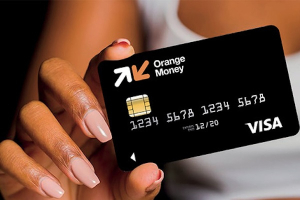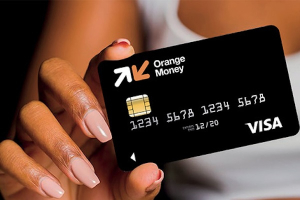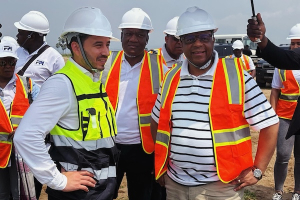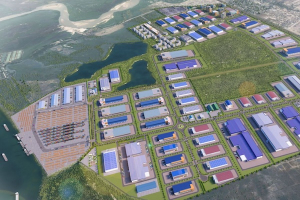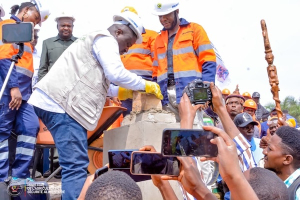Equipe Publication
Kwango : des projets pour accélérer l’accès à l’électricité
Le ministre des Ressources hydrauliques et de l’Électricité, Aimé Sakombi Molendo, a été auditionné le 14 décembre 2025 au Sénat sur la politique nationale de desserte en électricité en République démocratique du Congo (RDC). À cette occasion, il a présenté la stratégie d’électrification de la province du Kwango, axée sur le développement de nouvelles infrastructures énergétiques, principalement hydroélectriques.
Selon une note publiée par le ministère sur X (anciennement Twitter), le plan prévoit notamment un soutirage au poste de Bukangalonzo (220/33 kV – 75 MVA) afin d’alimenter la ville de Kenge. Il inclut également la construction de la centrale hydroélectrique de Mafiji, dont le potentiel est estimé à 63 MW, destinée à desservir les territoires de Kahemba, Tembo, Mawungu, Kasongo-Lunda et Popokabaka. Les études techniques sont actuellement en cours.
Le ministère mise par ailleurs sur la centrale hydroélectrique de Kingambo, dont la capacité est estimée entre 3 et 5 MW, pour l’électrification de la cité et du territoire de Feshi. À Popokabaka, un projet local d’électrification prévoit l’installation d’une mini-centrale solaire de 300 kWc pour la cité et son territoire.
Aimé Sakombi Molendo a également fait état de projets en cours d’exécution, dont la construction d’une mini-centrale photovoltaïque de 300 kWc et du réseau électrique associé pour la cité et le territoire de Kasongo-Lunda. L’avancement des travaux est estimé à 90 %, et une partie des équipements du réseau est déjà sur site. Ce projet est mis en œuvre par l’Agence nationale de l’électrification et des services énergétiques en milieux rural et périurbain (ANSER). Toutefois, selon des médias locaux, les travaux sont à l’arrêt depuis plusieurs mois : le 1er décembre, des habitants de Kasongo-Lunda ont manifesté pour en réclamer la reprise.
Le ministre a enfin annoncé un projet soutenu par l’Agence coréenne de coopération internationale (KOICA), portant sur la construction d’une mini-centrale solaire de 500 kWc destinée à alimenter l’Hôpital général de Kenge ainsi que les ménages environnants. Le lancement des travaux est prévu début 2026, à la suite de la signature d’un protocole d’accord entre le ministère et l’agence coréenne.
Ronsard Luabeya
Lire aussi :
DRC Warns Mining Firms Over Fuel Inspection Obstruction Under Subsidy Ban
The government of the Democratic Republic of Congo has reminded mining companies operating in the southeastern provinces of Haut-Katanga and Lualaba of their obligation to comply with new rules governing fuel use in the sector.
In a letter dated December 10, 2025, and signed by the Ministers of Hydrocarbons, Acacia Bandubola Mbongo, and Mines, Louis Watum Kabamba, the authorities said the reminder followed repeated refusals by several mining operators to grant access to their sites to inspectors from the Petroleum Product Marking Brigade.
According to the letter, the inspectors were seeking to verify fuel stocks in order to ensure that state-subsidized petroleum products intended for household consumption were not being diverted for industrial use at mining sites.
Under Article 22 of the 2025 Finance Law, fuels intended for land and aviation use in mining activities, including gasoline, kerosene, diesel, fuel oil, lamp oil and liquefied petroleum gas, or supplied to mining companies and their subcontractors, are excluded from all public subsidies. They are also no longer eligible for exemptions from import duties and taxes, notably customs duties and value-added tax.
To ensure enforcement of the measure, mining companies are now required to source their fuel supplies under customs supervision and to use products subject to specific molecular marking. This marking allows subsidized fuels sold at service stations to be clearly distinguished from fuels imported for industrial use.
Since the measure took effect in August, the Directorate General of Customs and Excise has suspected certain mining operators of attempting to circumvent the system. As a result, unannounced inspections were launched by the Petroleum Product Marking Brigade. However, between September 7 and 12, several inspection teams were denied access to fuel storage facilities at some mining sites in Lualaba province.
These incidents prompted the ministers to formally remind mining companies of their obligations and to call for full cooperation with inspection authorities.
In the letter, the ministers said that inspections by the Molecular Marking Brigade will now be conducted jointly with administrative checks by the hydrocarbons authorities. These inspections will focus in particular on installed fuel storage capacity, monthly fuel import and consumption volumes, the availability of customs declarations, and the validity of authorizations covering fuel importation, transport and storage for self-consumption.
According to Deputy Prime Minister in charge of the National Economy Daniel Mukoko Samba, the reform has already had a significant impact on public revenue. Fuel imports generated more than 63 billion Congolese francs, or about $22 million, in August 2025, compared with just 4 billion francs, or roughly $1.5 million, the previous month, representing a more than fifteen-fold increase.
Boaz Kabeya
Carburants : face au blocage des contrôles, l’État hausse le ton contre les miniers
Le gouvernement vient de rappeler à l’ordre les sociétés minières opérant dans le Haut-Katanga et le Lualaba, dans le sud-est de la République démocratique du Congo (RDC), au sujet du respect des nouvelles règles encadrant les carburants destinés à la consommation du secteur. Une correspondance, signée le 10 décembre 2025 par les ministres des Hydrocarbures (Acacia Bandubola Mbongo) et des Mines (Louis Watum Kabamba-Photo), leur a été adressée dans ce sens.
Selon ce courrier, ce rappel à l’ordre fait suite au refus de plusieurs compagnies minières d’autoriser les agents de la Brigade de marquage des produits pétroliers à accéder à leurs sites pour contrôler leurs stocks de carburants. Ces inspections visent à vérifier que les produits pétroliers subventionnés par l’État — destinés aux ménages — n’ont pas été détournés pour un usage industriel dans les mines.
La loi de finances 2025 (article 22) exclut désormais les carburants terrestres et d’aviation (essence, kérosène, gasoil, fuel, pétrole lampant, GPL) destinés à l’activité minière ou cédés aux entreprises minières et à leurs sous-traitants de toute subvention publique, ainsi que de toute exonération de droits et taxes à l’importation, notamment les droits de douane et la TVA. Pour garantir l’application de cette mesure, les sociétés minières doivent désormais s’approvisionner sous douane, et utiliser des carburants faisant l’objet d’un marquage spécifique permettant de les distinguer des produits vendus en stations-service.
Depuis l’entrée en vigueur de cette disposition en août, la Direction générale des douanes et accises (DGDA) soupçonne certains opérateurs miniers de contourner le dispositif. Des contrôles inopinés menés par la Brigade de marquage ont ainsi été lancés. Mais entre le 7 et le 12 septembre, plusieurs agents se sont vu interdire l’accès aux stocks pétroliers de certaines entreprises dans la province du Lualaba. D’où le rappel à l’ordre des ministres, qui appellent les acteurs miniers à une « bonne collaboration ».
Dans leur courrier, les ministres précisent que les missions de la Brigade de marquage moléculaire seront désormais systématiquement combinées à des contrôles administratifs menés par l’administration des Hydrocarbures. Ces vérifications porteront notamment sur les capacités installées de stockage, les volumes de carburants importés et consommés mensuellement, la disponibilité des déclarations douanières, ainsi que la validité des autorisations d’importation, de transport et de stockage pour autoconsommation.
Selon le vice-Premier ministre en charge de l’Économie nationale, Daniel Mukoko Samba, cette réforme a eu un impact immédiat sur les recettes publiques : les importations de carburants ont généré plus de 63 milliards de francs congolais (FC) en août 2025 — soit un peu plus de 22 millions de dollars — contre seulement 4 milliards de FC (1,5 million USD) le mois précédent, soit une hausse de plus de 1 500 %.
Boaz Kabeya
Lire aussi :
Haut-Katanga : des miniers dans le viseur pour non-respect des règles sur les carburants
Carburants : la fin des exonérations fiscales des miniers fait bondir les recettes en RDC
Orange Money, Visa Plan Virtual Card Launch In DRC
Orange Money Group plans to roll out virtual Visa cards across Africa and the Middle East, including the Democratic Republic of Congo (DRC). In a joint statement, Orange and Visa, a global leader in digital payments, said they had signed an agreement to support the expansion.
The virtual Visa card will be accessible via the Maxit application, which currently has 45 million active customers. Users will be able to instantly generate a rechargeable card from their Orange Money account, usable for online payments on local and international websites. A physical version of the card is also planned and will be made available later at authorized Orange Money points of sale.
In the DRC, Orange Money had already launched an Orange Money Visa card in June 2021 in partnership with UBA. Linked to the Orange Money account, it allowed funds to move between the card and the user’s mobile wallet. It remains unclear whether the initiative gained traction, but the current project builds on similar rollouts in Botswana, Madagascar, Jordan, and Ivory Coast. The goal is to “provide millions of users with a simple, secure, and internationally recognized payment solution.”
According to Thierry Millet, CEO of Orange Money Group, the launch of virtual cards for international payments marks the first phase of a broader agreement designed to expand Orange Money’s acceptance on e-commerce platforms and at local merchants.
The partnership comes as Visa strengthens its presence in the DRC through several collaborations with local banks and fintech companies. Last September, Visa signed an agreement with Onafriq, a pan-African digital payments network, to interconnect VisaPay with the country’s main mobile money wallets, including M-Pesa, Airtel Money, and Orange Money. The interoperability enables Visa accounts to be funded directly from mobile money wallets and facilitates electronic payments.
In the DRC, the value of digital transactions is expected to reach $3.85 billion in 2025, driven by an estimated average annual growth rate of 19%, according to the GSMA. Visa aims to capture part of this growth through the gradual rollout of its solutions, including the VisaPay application launched last September.
The Congolese mobile money market continues to grow strongly. According to data from the Regulatory Authority for Post and Telecommunications of Congo (ARPTC), Orange Money accounted for 6.611 million active accounts in the second quarter, out of a total of 31.16 million, representing a 19.3% increase from the previous quarter. The operator held a 21.22% market share, behind Vodacom’s M-Pesa (49.37%), Airtel Money (29.26%), and Africell (0.15%).
Ronsard Luabeya
Orange Money : le déploiement des cartes virtuelles Visa annoncé en RDC
Orange Money Group va bientôt déployer des cartes virtuelles Visa en Afrique et au Moyen-Orient, notamment en République démocratique du Congo (RDC). Dans un communiqué conjoint, Orange et Visa, leader mondial des paiements numériques, ont annoncé la signature d’un accord visant cet élargissement.
Concrètement, la carte virtuelle Visa sera accessible depuis l’application Maxit, qui compte actuellement 45 millions de clients actifs. L’utilisateur pourra générer instantanément une carte rechargeable à partir de son compte Orange Money, utilisable pour des paiements en ligne sur des sites locaux et internationaux. Une version physique de la carte est également prévue et sera disponible ultérieurement dans les points de vente agréés Orange Money.
En RDC, Orange Money avait déjà lancé, en juin 2021, une carte Visa Orange Money en partenariat avec UBA. Associée au compte Orange Money, elle permettait d’approvisionner la carte à partir du portefeuille mobile de l’utilisateur, et inversement. On ignore si cette initiative a rencontré un succès notable, mais le projet actuel s’inscrit dans la continuité d’expériences menées au Botswana, à Madagascar, en Jordanie et en Côte d’Ivoire. L’ambition est de « fournir à des millions d’utilisateurs une solution de paiement simple, sécurisée et reconnue internationalement ».
Selon Thierry Millet, PDG d’Orange Money Group, la création de cartes virtuelles pour les paiements internationaux constitue la première étape d’un accord plus large visant à renforcer l’acceptation d’Orange Money sur les plateformes d’e-commerce et chez les commerçants de proximité.
Ce partenariat intervient alors que Visa renforce sa présence en RDC à travers plusieurs collaborations avec des banques et des fintech locales. En septembre dernier, l’entreprise a notamment signé un accord avec Onafriq, réseau panafricain de paiements numériques, afin d’interconnecter VisaPay aux principaux portefeuilles mobile money du pays, dont M-Pesa, Airtel Money et Orange Money. Cette interopérabilité permet désormais d’alimenter un compte Visa directement depuis un portefeuille mobile money et de faciliter les paiements électroniques.
En RDC, la valeur des transactions numériques devrait atteindre 3,85 milliards de dollars en 2025, portée par un taux de croissance annuel moyen estimé à 19 %, selon la GSMA. Visa entend capter une partie de ce potentiel à travers le déploiement progressif de ses solutions, dont l’application VisaPay lancée en septembre dernier.
Le marché congolais du mobile money affiche une dynamique soutenue. Selon les données de l’Autorité de régulation de la poste et des télécommunications du Congo (ARPTC), sur un total de 31,160 millions de comptes actifs enregistrés au deuxième trimestre, Orange Money comptait 6,611 millions de comptes, soit une progression de 19,3 % par rapport au trimestre précédent. L’opérateur détenait ainsi 21,22 % de parts de marché, derrière M-Pesa de Vodacom (49,37 %), Airtel Money (29,26 %) et Africell (0,15 %).
Ronsard Luabeya
Lire aussi :
Télécoms : la licence unifiée redistribue les cartes entre les opérateurs en RDC
Télécoms : avec Sadou Diakité, Orange vise la première place en RDC
Kinshasa : Visa lance une application pour élargir l’accès aux services financiers
Cobalt Export Quota Snarl Threatens Miner Allocations as DRC Tests New System
With around two weeks remaining in 2025, the Democratic Republic of Congo is still piloting a new cobalt export procedure under its quota system. Many mining companies now say they will be unable to use their full annual allocations and are questioning what will happen to any unused quotas.
Under an Oct. 10, 2025 decision by the board of the Regulatory and Control Authority for Strategic Mineral Substances Markets (ARECOMS), which set the conditions for obtaining, allocating, and executing cobalt export quotas, base quotas per operator are neither transferable nor carried over into a future period. The decision states that any monthly export quota not used by the last day of the month in question is considered lost and automatically reallocated to ARECOMS’ annual strategic quota.
The decision includes an exception for this year. Monthly quotas per operator are exceptionally cumulative until Dec. 31, 2025, but no carryover from one year to the next is permitted. If applied strictly, companies unable to export their full 2025 quotas would forfeit them. Industry representatives say this would be unfair, arguing that the delays are not the operators’ fault.
Asked to comment, ARECOMS told Bloomberg that quotas from the last quarter would not be lost by mining companies and that it was examining all implementation options to limit the impact. The U.S. media also said DRC authorities had allowed producers to retain their 2025 quotas. However, as of the end of last week, several industry players said they had received no official notification to that effect.
Cobalt exports were due to resume on Oct. 16 but remained blocked for more than a month due to the lack of formal implementing rules required under ARECOMS directives. The interministerial Mines and Finance circular setting out the practical arrangements for cobalt exports was published only on Dec. 2. According to the Mining Chamber of the Federation of Enterprises of Congo (FEC), the document does not address concerns raised by cobalt exporters.
Authorities have since launched a testing phase, which began last week with a small shipment of cobalt belonging to Glencore, the owner of Kamoto Copper Company (KCC) and Mutanda Mining (MUMI) in Greater Katanga. “All means are being deployed to finalize the testing phase in the coming days, which will mark the resumption of cobalt exports from the DRC,” ARECOMS told Bloomberg.
Operators hope that once this phase is completed, the regulator will agree to talks to clarify ambiguities in the new system. According to industry sources, as of the end of last week, Mines Minister Louis Watum Kabamba had not responded to correspondence sent by the Mining Chamber on Dec. 4 requesting a working session under the consultation mechanism established in October.
For the fourth quarter of 2025, ARECOMS authorized the export of 18,125 tonnes of cobalt. CMOC and Glencore hold 58% of these volumes, with allocations of 6,500 tonnes and 3,925 tonnes respectively. Annual production is expected to reach nearly 200,000 tonnes.
Pierre Mukoko & Ronsard Luabeya
Cobalt en RDC : l’incertitude plane sur le sort des quotas d’exportation de 2025
A deux semaines de la fin de l’année 2025, la République démocratique du Congo (RDC) en est encore à tester la nouvelle procédure d’exportation du cobalt prévue dans le cadre du système de quotas. Pour de nombreuses entreprises minières, il apparaît désormais évident qu’elles ne pourront pas utiliser l’ensemble des volumes qui leur ont été attribués pour 2025. Elles s’interrogent dès lors sur le sort des quotas non utilisés.
Selon la décision du 10 octobre 2025 du conseil d’administration de l’Autorité de régulation et de contrôle des marchés des substances minérales stratégiques (Arecoms), fixant les conditions d’obtention, de répartition et d’exécution des quotas d’exportation du cobalt, « les quotas de base par opérateur ne sont ni transférables, ni reportables dans le temps ». Autrement dit, « tout quota d’exportation mensuel non utilisé au dernier jour du mois en question sera considéré comme perdu et automatiquement réaffecté au quota stratégique annuel de l’Arecoms ».
Le texte prévoit toutefois une exception pour cette année : « Les quotas mensuels par opérateur seront cumulables de manière exceptionnelle jusqu’au 31 décembre 2025 ». En revanche, aucun report d’une année à l’autre n’est envisagé. Si cette règle devait être strictement appliquée, les compagnies incapables d’exporter la totalité de leurs quotas 2025 devraient donc les perdre. Une perspective que la filière juge injuste, estimant que les retards constatés ne sont pas imputables aux opérateurs.
Sollicitée par Bloomberg, l’Arecoms a affirmé : « Les quotas du dernier trimestre ne seront pas perdus par les sociétés minières. Nous examinons toutes les options de mise en œuvre pour limiter les impacts ». L’agence américaine indique également que les autorités auraient autorisé les producteurs à conserver leurs quotas 2025. Cependant, jusqu’à la fin de la semaine dernière, plusieurs acteurs du secteur affirmaient n’avoir reçu aucune notification officielle en ce sens.
Dialogue sollicité
Les exportations de cobalt auraient dû reprendre depuis le 16 octobre, mais elles sont restées bloquées plus d’un mois en raison de l’absence de texte codifiant la nouvelle procédure induite par les directives de l’Arecoms. La note circulaire interministérielle Mines/Finances fixant les dispositions pratiques de l’exportation du cobalt n’a été publiée que le 2 décembre. Selon la Chambre des mines de la Fédération des entreprises du Congo (FEC), ce document « ne répond pas aux préoccupations soulevées par les exportateurs de cobalt ».
Les autorités ont donc lancé une phase de test, amorcée la semaine dernière, à partir d’« une petite cargaison » de cobalt appartenant à Glencore, propriétaire de Kamoto Copper Company (KCC) et Mutanda Mining (MUMI) dans le Grand Katanga. « Tous les moyens sont déployés pour finaliser la phase de test dans les prochains jours, ce qui marquera la reprise des exportations de cobalt depuis la RDC », a indiqué l’Arecoms à Bloomberg.
Les opérateurs espèrent qu’à l’issue de cette phase, le régulateur acceptera enfin un dialogue pour clarifier les zones d’ombre du nouveau dispositif. Selon nos informations, à la fin de la semaine dernière, le ministre des Mines, Louis Watum Kabamba, n’avait toujours pas répondu à la correspondance que la Chambre des mines lui a adressée le 4 décembre, sollicitant une séance de travail dans le cadre du mécanisme de concertation créé en octobre.
Pour le dernier trimestre 2025, l’Arecoms a autorisé l’exportation de 18 125 tonnes de cobalt. CMOC et Glencore concentrent 58 % de ces volumes, avec respectivement 6 500 tonnes et 3 925 tonnes. La production annuelle est attendue à près de 200 000 tonnes.
Pierre Mukoko et Ronsard Luabeya
Lire aussi :
Cobalt : les exportations toujours bloquées en RDC, les nouvelles règles en cause
Reprise des exportations de cobalt : la RDC débloque la dernière étape administrative
Cobalt : la RDC attribue les quotas, CMOC capte la plus grosse part mais…
ARISE IIP Seeks FPI Equity Participation in Three DRC Special Economic Zones
The Democratic Republic of Congo’s Industrial Promotion Fund (FPI) said ARISE Integrated Industrial Platforms (ARISE IIP) has asked it to take equity stakes in special economic zones developed by the firm in the country.
ARISE IIP is seeking to partner with the FPI on three SEZ projects. The first is the Kin-Malebo Special Economic Zone, where ARISE IIP holds a 60% stake and the Congolese state owns the remaining 40%. FPI Director General Hervé-Claude Ntumba Batukonke visited the site on Dec. 6, 2025. The project is currently 80% complete.
The second project is the Musompo Special Economic Zone in Kolwezi. When construction was launched on March 26, 2025, the Lualaba provincial government presented ARISE IIP as a partner for the zone, which is designed to produce battery precursors and batteries and could also include electric-vehicle assembly using locally sourced raw materials. No further details were disclosed.
The third project is the Banana Special Economic Zone, which aims to support the development of a deep-water port.
The FPI described the proposal as a “major strategic opportunity,” noting that it aligns with its Three-Year Action Plan for 2026-2028, adopted last September. The plan identifies the diversification of funding sources as one of the fund’s five priorities, including the use of innovative mechanisms such as equity participation and project co-financing. The objective is to expand the fund’s impact beyond traditional industrial project financing.
To date, the FPI has mainly focused on financing industrial projects, promoting local industry, supporting research and innovation, and developing economic infrastructure. Between April 2024 and May 2025, the institution allocated nearly $6.5 million in credit to six projects across several sectors, including pharmaceuticals, furniture, beverages, soaps and printing, according to data published on its website.
Timothée Manoke
First Phase of ARISE-Backed Kin-Malebo Industrial Zone 80% Complete
The first phase of development at the Kin-Malebo Special Economic Zone (SEZ) is nearing completion, with 80% of construction work finished, the Industrial Promotion Fund (FPI) said.
The update came after a site visit on December 6, 2025, by FPI Director General Hervé-Claude Ntumba Batukonke. The project is located in Kinshasa’s N’Sele municipality, about 40 km from the city centre and 10 km from Ndjili International Airport.
ARISE Integrated Industrial Platforms (ARISE IIP) announced a public-private partnership with the Democratic Republic of Congo for the development of the SEZ in September 2022. At the time, the company said the project would involve an estimated $200 million investment, with a 60% stake held by ARISE and 40% by the state, and would generate around 20,000 direct and indirect jobs. The zone was also expected to attract about $850 million in private investment across multiple sectors.
Figures for the site’s size have varied since the project’s launch. ARISE initially put the area at 514 hectares at the time of the partnership agreement, while the Congolese Agency for Major Works (ACGT) refers to 497 hectares. ARISE’s official platform now lists 528 hectares for the first phase.
ARISE said the initial phase is expected to include wood processing, poultry production and beverage manufacturing for the local market, as well as companies operating in pharmaceuticals, plastic recycling, household appliances, electric vehicles and other processing industries.
In July 2025, the Ministry of Industry said the zone would be inaugurated before the end of the year, adding that several companies had already secured plots within the industrial area.
ARISE had initially planned to begin construction in October 2022, one month after signing the partnership, with operations starting in October 2023. However, the ACGT said site development work did not begin until April 2024. No explanation was given for the delay.
ARISE IIP describes itself as a pan-African developer and operator of industrial parks and currently manages 12 special economic zones in countries including Rwanda, Gabon, Togo and Benin.
Timothée Manoke
$160M Approved To Improve Connectivity Around Ngandajika Agro-Industrial Park
The African Development Bank (AfDB) on Dec. 8 approved $160 million in financing to improve transport and logistics links around the Ngandajika Agro-Industrial Park (PAIN) in Lomami province, in the Democratic Republic of Congo.
The project’s total cost is estimated at $177.16 million, with the Congolese government covering the balance. Construction work was officially launched on Dec. 2 by Minister of State for Agriculture Muhindo Nzangi.
According to the AfDB, the project aims to reduce the isolation of the PAIN area and better integrate it into the central DRC’s main economic corridors. It includes the construction and rehabilitation of the Nkuadi-Ngandajika-PAIN and Lukalaba-Ngandajika road corridors, as well as upgrades to connecting roads between the RN1 and RN2 national highways. The plan also includes an extension of the runway at Mbuji-Mayi airport to support agri-business freight operations.
The investments are expected to benefit farmers, transport operators and agri-businesses in Kasaï-Oriental and Lomami by lowering logistics costs and improving access to markets. Women and young people, who play a key role in local agricultural value chains, are also expected to gain from the expanded economic opportunities.
Léandre Bassolé, the AfDB’s Director General for Central Africa, said the financing marks “a major step forward for Central Africa’s economic integration and for the industrialization of agriculture in the DRC.” He added that the project is not limited to road infrastructure but is designed to strengthen agricultural value chains and develop new trade corridors, boosting competitiveness and economic inclusion.
The project is part of the Agricultural Transformation Program (PTA) and complements the Support Program for the Development of the Ngandajika Special Agro-Industrial Processing Zone (PRODAN).
In October, the agriculture ministry launched a tender to recruit contractors for several design-and-build components of the PAIN. These include site development, construction of internal roads, connection to the high- and medium-voltage power grid, installation of drinking water systems, deployment of internal fibre-optic networks, and construction of a one-stop service centre and an agricultural aggregation and services hub.
Ronsard Luabeya





